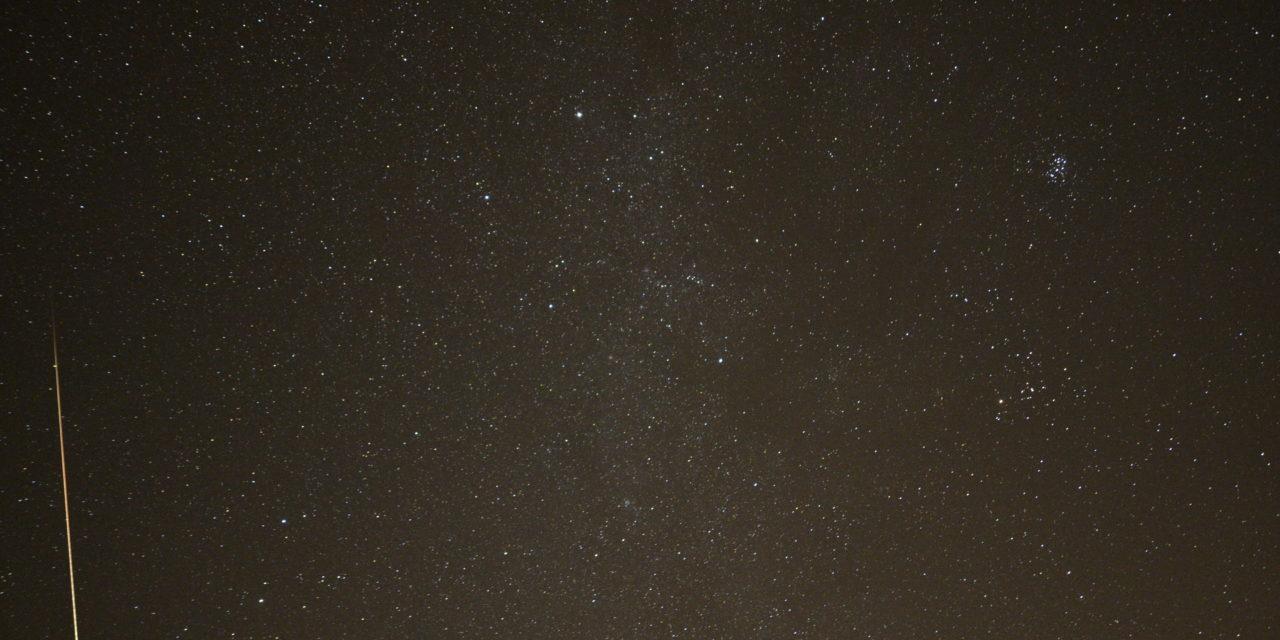Introduction:
A presentation is given of my observations on October 17/18, 2020. A total of 86 meteors were observed in a total of 4.87 hours effective observing time, and 13 meteors were photographed with my DSLR camera. Two beautiful fireballs were also observed visually this night. One of them was caught on video by the Norwegian Meteor Network, the other one was photographed with my DSLR camera.
Observations:
22:25 – 23:45 Teff: 1.283, F: 1.00, Lm: 6.23, RA: 45, Dec: +50 – 3 minutes brake
Spo: -4, -1, 2(2), 3(2), 4(2), 5(2) – 10 meteors
STA: 2, 3 – 2 meteors
DAU: 0 meteors
EGE: 0 meteors
ORI: 1 – 1 meteor
LMI: 2 – 1 meteor
After a long run with clear nights, the weather forecast indicated that this night would be my last chance to observe this years Orionids. I was therefore hoping for an increase in the Orionid activity, and hopefully more bright meteors than the night before, which only yielded one meteor brighter than +2 during the whole night. After only 12 minutes of observations my prayers were heard, with a beautiful, slow moving, -1 magnitude sporadic radiating out of Draco and moving into Ursa Major. Fifteen minutes later I became aware of a slow moving light in the outskirts of my observation field. I turned my head and could follow a very slow moving fireball low in the southern horizon for several seconds. The meteor appeared to be white in color and had several flares along its path. The fireball was photographed by the Norwegian Meteor Network, and any remnants would have fallen into the sea just north of Denmark. More information and videos about this meteor can be found here: http://norskmeteornettverk.no/meteor/20201017/225143/
23:45 – 01:00 Teff: 1.250, F: 1.00, Lm: 6.23, RA: 60, Dec: +45
Spo: -4, 2(2), 3(3), 4(4), 5, 6 – 12 meteors
STA: 3(3) – 3 meteors
DAU: 1 – 1 meteor
EGE: 2, 4, 5 – 3 meteors
ORI: 2, 3(3), 4(2), 5, 6 – 8 meteors
LMI: 4 – 1 meteor
With rising radiant elevation, the Orionids became more active. 8 meteors were seen during this 1,25 hour period, all in the magnitude range between +2 and +6. Also, the Epsilon Geminids and the Southern Taurids showed some nice activity, with 3 meteors each. Together with 12 sporadics, 1 DAU and 1 LMI, the total meteor count for the period was 28. An entertaining and rewarding period reached its climax at 00:25 UT. On the border between Lynx and Ursa Major a bright yellow light started to emerge, gaining brightness as it slowly moved through Cancer, before ending in a bright flash near the horizon in Hydra. The fireball reached magnitude -4, maybe even brighter at its final flare. I was lucky to catch this meteor in the outskirts of my camera field but missing its endpoint in Hydra.

Photo taken with a Nikon D3100 camera, with a Samyang 16mm F 2.0 lens. Exposure time was 20 seconds, with ISO 1600 settings. The brightest star in the upper middle of the photo is Capella.
01:00 – 02:20 Teff: 1.167, F: 1.00, Lm: 6.23, RA: 60, Dec: +45 – 10 minutes brake
Spo: 1, 3(2), 4(3), 5(3), 6 – 10 meteors
STA: 0 meteors
DAU: 0 meteors
EGE: 0 meteors
ORI: 1(2), 2(2), 3(4) – 8 meteors
LMI: 1 – 1 meteor
Orionid activity kept up in the third period with a total of 8 meteors, with a couple of nice +1 magnitude meteors. A decent +1 magnitude LMI was also seen in Ursa Major, but activity from the STA, EGE and DAU showers were absent. With 10 sporadic meteors seen, the total count in this period came in at 19 meteors.
02:20 – 03:30 Teff: 1.167, F: 1.00, Lm: 6.23, RA: 75, Dec: +40
Spo: 1, 2, 3, 4(4), 5(3), 6(2) – 12 meteors
STA: 2(2), 4(3), 5, 6 – 7 meteors
DAU: 0 meteors
EGE: 3 – 1 meteor
ORI: 3, 4(2) – 3 meteors
LMI: 0, 3 – 2 meteors
Meteor activity picked up a little in the last period. A total of 25 meteors were seen, most of them in the magnitude range +3 to +5. After a quiet period, the Taurids were on the rise again, with 7 meteors observed. For some reason Orionid activity fell to 3 meteors, even though the radiant now was high in the sky. Another successful night of meteor observing was rounded off with a beautiful 0 magnitude LMI in Auriga.






